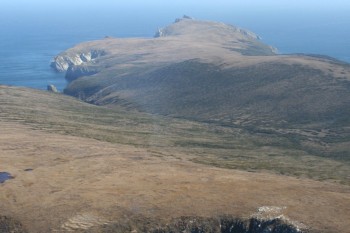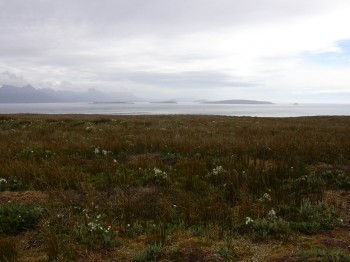The Isla de los Estados (Staten Island) group comprises an archipelago belonging to Argentina with the main island of the same name, as well as Islas Año Nuevo, Islas Dampier, Islas Menzies and several smaller islets. The group lies some 30 km of the Argentinian coast of Tierra del Fuego in the South Atlantic.
Southern Giant Petrels Macronectes giganteus are known to breed on two islands in the group. The species was first described from a specimen collected in waters around Isla de los Estados by James Cook´s Second Expedition in January 1775.
The archipelago is a “Reserva provincial ecológica, histórica y turística” (Historical, Environmental and Tourist Reserve) according to the Constitution of the Province of Tierra del Fuego, Antártida e Islas del Atlántico Sur.
Isla de los Estados
The main island of Isla de los Estados has an elongated shape about 65 km in length with maximum and minimum width of 16 km and 500 m, due to the existence of many fjords and bays. Its area is 534 km² and maximum elevation is 823 m. Its spectacular geography together with its forest vegetation made it a perfect refuge for sailors, sealers and whalers in the past. The only settlement is a naval station manned by marines.

Bahía San Antonio, Isla de los Estados
Isla de los Estados hosts a colony of ACAP-listed Southern Giant Petrels on Peninsula Lopez, at the south-western end of the island. Their presence was first recorded in 1972 and observed several times in overflights of the island. In December 2011 eight active nests were present.

Península López, Isla de los Estados. Southern Giant Petrels breed on top of the ridge

Southern Giant Petrels breeding at Peninsula López
Photograph by A. Raya Rey
Isla Observatorio
Isla Observatorio is the largest island of the Islas Año Nuevo group. It has an area of about 4 km² and a flat relief of no more than 60 m above sea level. The island has hosted a lighthouse since 1902 (now automatic) and held a magnetic and meteorological observatory during the first two decades of the last century. Human presence has led to the introduction of exotic species such as the Black Rat Rattus rattus and the European Rabbit Oryctolagus cuniculus.

Isla Observatorio from the air, showing the Año Nuevo lighthouse. One of the main Southern Giant Petrel breeding sites is above and to the right of the lighthouse

Breeding area of Southern Giant Petrels on Isla Observatorio
In the distance are other islands in the Islas Año Nuevo group and the main island of Isla de los Estados

A Southern Giant Petrel on its nest on Isla Observatorio
Isla Observatorio hosts a colony of Southern Giant Petrels. In January 2004 500 active nests were present. The birds breed in elevated areas on the island, in sectors characterized by shrubby vegetation with Marsippospermum grandiflorum and Chilliotrichum diffusum that provide some protection against the wind.
All photographs by Adrián Schiavini unless stated.
Selected References:
Imshaug, H.A. 1972. R/V Hero cruise 71-5 to Isla de los Estados. Antarctic Journal of the United States 7(2): 42-44.
Patterson, D.L., Woehler, E.J., Croxall, J.P., Cooper, J., Poncet, S., Peter, H.-U., Hunter, S. & Fraser, W.R. 2008. Breeding distribution and population status of the Northern Giant Petrel Macronectes halli and Southern Giant Petrel M. giganteus. Marine Ornithology 36: 115-124.
Click here for the paper's separate appendices with historical count data.
Quintana F., Schiavini A. & Copello, S. 2005. Estado poblacional, ecología y conservación del petrel gigante del sur (Macronectes giganteus) en Argentina. El Hornero 20: 25-34.
Schiavini, A.C.M., Frere, E., Yorio, P. & Parera, A. 1999. Las aves marinas de la Isla de los Estados, Tierra del Fuego, Argentina: revisión histórica, estado poblacional y problemas de conservación. Anales del Instituto de la Patagonia, Serie Ciencias Naturales (Chile) 27: 25-40.
Shirihai, H. 2007. A Complete Guide to Antarctic Wildlife. The Birds and Marine Mammals of the Antarctic Continent and the Southern Ocean. London: A & C Black. pp. 524-525.
Adrián Schiavini, Ecología y Conservación de Vida Silvestre, Consejo Nacional de Investigaciones Científicas y Técnicas (CONICET), Centro Austral de Investigaciones Científicas (CADIC), Ushuaia, Argentina, 21 November 2013

 English
English  Français
Français  Español
Español